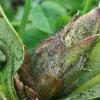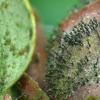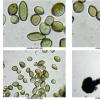
07-12-2025 16:07
Arnold BüschlenHallo, ich habe in einer Moos-Aufsammlung (epiohy

05-12-2025 17:33
 Bruno Coué
Bruno Coué
Bonjour, je serais heureux de recueillir votre avi

07-12-2025 09:24
De la pasada semana en Galicia EspañaEn el suelo

06-12-2025 00:19
 Viktorie Halasu
Viktorie Halasu
Hello, would anyone have this article, please? An

02-12-2025 18:59
This pair of ascos 2.5cm across were on recently b
 Sur bourgeon de Rhododendron. Je suis pratiquement certain qu'il s'agit de Pycnostysanus azaleae mais comme c'est la première fois que je le vois, je souhaiterais une confirmation.
Sur bourgeon de Rhododendron. Je suis pratiquement certain qu'il s'agit de Pycnostysanus azaleae mais comme c'est la première fois que je le vois, je souhaiterais une confirmation.Conidies variables de forme : ellipsoïdes, subglobuleuses, citriformes, fusoïdes… : 5,5-11x5-5,5
Bernard

Dear Bernard,
your determination is correct. The species is quite common on cultivated Rhododendron and is transfered by the cicada Graphocephala fennahi (which is quite beautiful!).
Regards from Lothar

Thank you for your confirmation, to update the name of the fungus and the name of the cicada responsible for the appearance of the fungus!
Sincerely,
Bernard
Hello All,
Looks like this disease of Rhododendrons is spreading. It occurs regularly each year on a hybrid shrub in our garden in North Argyll, Scotland.
What is a puzzle, is what is the transmission agent as we are definitely not within range of Cicadas!
Kind regardes,
Peter

We're in range - Graphocephala fennahi (Graphocephala coccinea) is a leafhopper related to cicada's: http://scholar.lib.vt.edu/ejournals/JARS/v34n4/v34n4-wheeler.htm
And yes, a very distinctive looking beastie!
With regards,
Jenny




